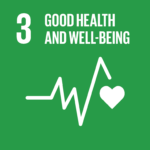Women are more exposed to plastics than men. Women face heightened vulnerability to these toxins due to biological factors. Their metabolism, with higher estrogen levels and greater fat volume for storing toxins, makes them more susceptible to EDCs’ effects.
In an era where environmental concerns are paramount, the impact of plastic pollution extends beyond ecological damage, disproportionately affecting women’s health and exacerbating social inequalities. Recent studies have unveiled a troubling connection between ubiquitous plastic products and a range of health issues that particularly target women.
RELEVANT SUSTAINABLE GOALS



Microplastics: A Poison Like No Other
The Endocrine Society’s 2020 report, “Plastics, Health and Endocrine Disruptors,” revealed a startling fact: 144 chemicals from plastics were detected in the bodies of surveyed individuals. These substances, known as endocrine-disrupting chemicals (EDCs), interfere with hormone systems and pose significant risks even at low doses.
Women face heightened vulnerability to these toxins due to biological factors. Their metabolism, with higher estrogen levels and greater fat volume for storing toxins, makes them more susceptible to EDCs’ effects. This sensitivity is particularly acute during key life stages such as puberty, pregnancy, lactation, and menopause.
The pervasive nature of plastic-derived chemicals in everyday products amplifies the risk. Phthalates, a type of EDC used to enhance plastic durability, are commonly found in cosmetics, lotions, and personal care items. Exposure to these chemicals has been linked to hormone disruption, reproductive problems, and certain cancers.
Ironically, products designed for women’s use often contribute to their exposure. Feminine hygiene products, many containing bisphenol A (BPA) or bisphenol S (BPS), are used an estimated 11,000 times during a woman’s lifetime. Beauty products pose additional risks, with a study by Noteo finding that 40% of 15,000 beauty-hygiene products examined contained at least one endocrine disruptor.
Women And Children, the First victims of plastic pollution
The issue extends beyond individual health to societal structures. Traditional gender roles in many societies place women at the forefront of household maintenance, increasing their exposure to toxic substances in cleaning products. In developing countries, women and children often work as waste pickers, facing direct exposure to hazardous materials in landfills.
Experts argue that this situation represents not just a health crisis but a social injustice. The United Nations reports that women perform at least two and a half times more household chores than men, a disparity that inadvertently increases their exposure to harmful chemicals.
While alternatives exist, such as menstrual cups and natural personal care products, they are not universally accessible. Advocates call for comprehensive measures to protect all individuals from plastic-related health risks, urging industries to consider women’s biological factors in product design and composition.
As awareness grows, recommendations for reducing exposure include using BPA-free products, avoiding heating plastics, choosing natural personal care items, and filtering tap water. However, experts stress that individual actions alone are insufficient. They call for global, concrete measures to ensure that all people, regardless of gender or socioeconomic status, are protected from the insidious health risks posed by our pervasive use of plastics.
You may also be interested in :
The Case Of Martha Sabar: Are Health Systems Failing Mothers?


